|
 Russula kermesina Russula kermesina
SynonymsMacowanites carmineus
BiostatusPresent in region - Indigenous. Endemic
Images (click to enlarge)
Caption: Macowanites carmineus: m, spores; n, basidium; o, pleurocystidia | 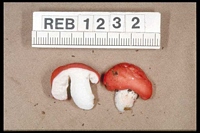
Owner: R.E. Beever | 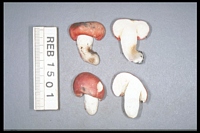
Owner: R.E. Beever | 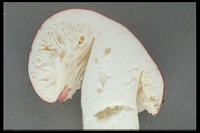
Owner: R.E. Beever | 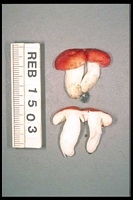
Owner: R.E. Beever | 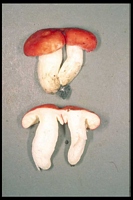
Owner: R.E. Beever | 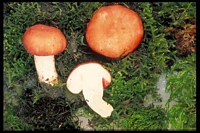
Owner: R.E. Beever | 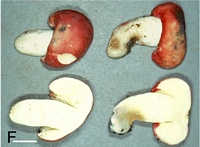
Caption: Fig. 3 F, Macowanites
carmineus; Scale bar = 10 mm. | 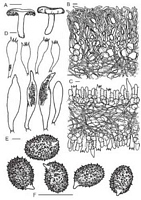
Caption: Fig. 12 Macowanites carmineus. A, Basidioma; B, peridiopellis and peridial context; C,
hymenophoral trama and hymenium; D, basidia; E, hymenoph | 
Caption: Fig. 13 Spores of Macowanites
carmineus. Scale bars = 10 mm. | 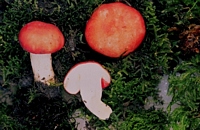
Caption: REB 1505
Owner: Ross Beever | 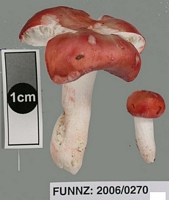
Caption: FUNNZ: 2006/0270, See public note for more information
Owner: FUNNZ | 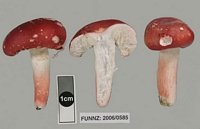
Caption: FUNNZ: 2006/0585, See public note for more information
Owner: FUNNZ | 
Caption: ZT68-006
Owner: E. Horak: © Creative Commons Attribution-Noncommercial 3.0 New Zealand | 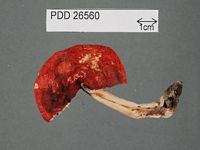
Caption: Dried type specimen
Owner: Herb PDD | 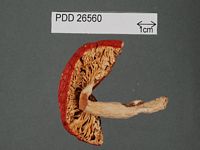
Caption: Dried type specimen
Owner: Herb PDD | 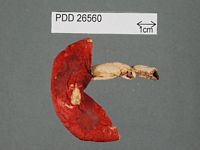
Caption: Dried type specimen
Owner: Herb PDD | 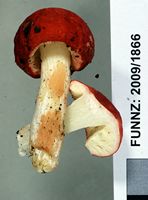
Owner: J.A. Cooper |
Article: McNabb, R.F.R. (1971). Some new and revised taxa of New Zealand Basidiomycetes (Fungi). New Zealand Journal of Botany 9(2): 355-370 (http://www.rsnz.org/publish/abstracts.php).
Description: Gastrocarps 3-6 cm diam., hemispherical to depressed-globose with strongly involute margins when young, centrally depressed with involute margins at maturity, slightly viscid, glabrous, innately pruinose under lens, velar remnants absent, bright carmine red to madder red, red pigment leaching under wet conditions; cuticle a trichodermium palisade. Composed of short, filamentous, septate, thin-walled hyphae 3-5 nm diam. arising from connective hyphae or sphaerocysts, terminal cells with bluntly-acuminate, rounded, or occasionally inflated apices, trichodermium becoming disorganised with age and somewhat gelatinised; pilocystidia absent. Gleba basically lamellate, attached to apex of stipe-columella, convoluted, glebal plates thin, fragile, chalk white, radiating from stipe-columella to margin, forming mainly narrow chambers open towards the lower surface, to 10mm deep, exposed. Stipe-columella 3-5.5 cm long, more or less equal, or slightly tapered basally, 1.4-1.8 cm diam., solid to hollowed, dry, subglabrous, faintly longitudinally striate, chalk white; cuticle composed of interwoven hyphae 2.5-4.5 µm diam., terminal cells aggregated and projecting in places. Context of peridium white, firm, unchanging on exposure to air, heteromerous, composed of connective hyphae and numerous nests of sphaerocysts.
Spores broadly elliptical, obliquely apiculate, apiculus to 1.5-(2) µm. long, 8.2-10.5-(12) x 6-7.5-(8.2) µm, ornamentation of strongly amyloid verrucae to 0.7 µm high, in groups of 2-3, joined by fine amyloid ridges and forming an incomplete reticulum, or occasionally isolated, plage indistinct. Hymenium continuous: basidia hyaline, clavate or irregularly clavate, 21-39 x 8.5-12 µm, 4-spored, sterigmata to 7 µm long; pleuro-cystidia scattered, broadly fusiform with acuminate, mucronate, or strangulate apices, sometimes clavate with or without mucronate apices, hyaline, thin-walled, contents refractive in KOH, not or only slightly projecting beyond basidia, 60-87 x 10-17.5 µm. Hymenophoral trama intermixed; subhymenium well developed, of small cellular elements; mediostratum heteromerous, of connective hyphae and isolated nests of sphaerocysts; clamp connections absent, all hyphae inamyloid. Taste mild. Chemical characters: formalin on context-n.r.; phenol on context-slowly deep vinaceous; FeSO4 on context-n.r.; guaiacol on stipe-columella base-n.r.; KOH on peridium-bleaching action on red colour leaving area pallid orange; on context-faint yellow; NH4OH on pileus-faint purplish flush; on context-n.r.
Habitat: Solitary or in small groups under Nothofagus
Notes: This brightly coloured Gasteromycete could easily be mistaken for a Russula. A spore print could not be obtained despite repeated attempts, and this character together with the wrinkled, lamellae-like glebal plates, indicates that it belongs in the astrogastraceous series of the Secotiaceae rather than the Russulaceae. Phylogenetically, Macowanites occupies an interesting position, linking the Gasteromycetes with the Agaricales, Both Macowanites and Russula possess amyloid spore ornamentation and sphaerocysts. The single fundamental character separating the two is the presence of active spore discharge in Russula. The evolutionary line leading from the astrogastraceous series of the Secotiaceae to the Russulaceae is well documented (Singer and Smith, 1960), and Smith (1963) has placed these fungi together in a single order, the Russulales.
Macowanites possesses an interesting geographical distribution. With the exception of the type species M. agaricinus (Kalchbr.) Kalchbr., which was collected, in South Africa, all remaining species are of North Temperate distribution, with the majority occurring in north-western states of the U.S.A. Of the species of Macowanites keyed out by Smith (1963), M. carmineus appears to be most closely allied to M. pseudo-emeticus A. H. Smith, but differs in the chalk-white glebal plates, longer and narrower spores with more prominent ornamentation, and longer pleurocystidia.
Article: Lebel, T. (2002). Sequestrate Russulales of New Zealand: Gymnomyces and Macowanites. New Zealand Journal of Botany 40(3): 489-509 (http://www.rsnz.org/publish/abstracts.php).
Description: Basidiomata 30-60 mm diam., hemispherical to depressed-globose with strongly involute
margins when young, centrally depressed with involute margins at maturity, stipitate. Pileal
surface slightly viscid, glabrous to slightly pruinose, bright carmine red to madder red, red
pigment leaching under wet conditions. Context white, firm, unchanging with age. Gleba chalk
white, sublamellate to labyrinthine, attached to apex of stipe-columella, convoluted glebal
plates radiating from stipe-columella to margin, forming narrow locules exposed at
lower margin of pileus. Stipe 25-65 x 8-18 mm, more or less equal, or slightly tapered at base,
solid to hollowed, dry, faintly longitudinally striate, surface and context chalk white.
Columella percurrent, simple, white. Odour and taste mild. Latex absent. Chemical characters:
formalin on context, no reaction; phenol on context, slowly deep vinaceous; FeSO4 on context,
no reaction; guaicol on stipe columella base, no reaction; KOH on peridium, bleaching action
on red colour leaving pallid orange area; on context, faint yellow; NH4OH on peridium, faint
purplish flush; context, no reaction. Pileipellis 92-155 µm wide, a trichodermium
palisade composed of short, filamentous, septate, thin-walled, hyaline hyphae 3-5 µm diam.,
arising from connective hyphae or inflated cells 14-29 µm diam.; terminal cells with bluntly
acuminate, rounded, or occasionally inflated apices, trichodermium becoming disorganised
with age and somewhat gelatinised. Pileus context 70-110 µm wide, heteromerous, composed
of interwoven, hyaline hyphae 2-3.5 µm diam. and abundant sphaerocysts 12-29 µm diam. in
nests. Endocystidia absent. Stipitipellis composed of interwoven hyphae 2.5-4.5 µm diam.,
terminal cells aggregated and projecting in places. Stipe-columella context heteromerous, of
interwoven, hyaline hyphae 2-3 µm diam. and abundant sphaerocysts 17-25 µm diam. in
nests. Hymenophoral trama 52-85 µm wide, heteromerous, of interwoven, hyaline hyphae 2-4
µm diam. and isolated nests of sphaerocysts 12-24 µm diam. Subhymenium well
developed, 18-28 µm wide, with 2-3 tiers of isodiametric cells -11 µm
diam. (somewhat compressed). Basidia 21-39 x 8.5-12 µm, hyaline, clavate, with 4 sterigmata
4-7 µm long. Cystidia 60-87 x 10-17.5 µm, hyaline, broadly fusiform with acuminate or
mucronate apices, sometimes clavate with or without mucronate apices, thin-walled,
contents refractive in KOH; not or only slightly projecting beyond basidia, scattered. Spores
8-10.5(12) x 6-7.5(8.5) µm (9.1 ± 0.34 x 6.9 ± 0.22), Q = 1.23-1.27, broadly ellipsoid,
heterotropic and asymmetric, wall hyaline. Ornamentation amyloid, of warts 0.4-0.8 µm high,
often 2 or more joined by fine, low lines to sometimes form a partial reticulum, with scattered
isolated elements. Hilar appendix eccentric, conspicuous, tapered, 0.5-1 x 1-2 µm; plage
indistinct, inamyloid. Spore colour in mass in the locules of the dried gleba appear
cream coloured.
Habitat: HABITAT AND DISTRIBUTION: Epigeous or emergent, solitary or in small groups under
leaf litter in Nothofagus menziesii and N. truncata forest. Fruiting period Jan, Mar-May.
Notes: NOTES: This was the first species of Macowanites to be described from Australia or New
Zealand. The basidiomata of M. carmineus range in appearance from very like an aborted
Russula to distinctly secotioid. However, even in the more robust specimens anastamoses
between lamellae are common, forming large labyrinthine chambers, and a spore print is
unobtainable. Although Macowanites rubroluteus may also have a red peridium, the gleba is
loculate not sublamellate, and the stipe-columellais never as robust. Microscopically, M.
rubroluteus has spores ornamented with isolated spines whereas in M. carmineus the spore
ornamentation is lower and in short lines or a partial reticulum.
|